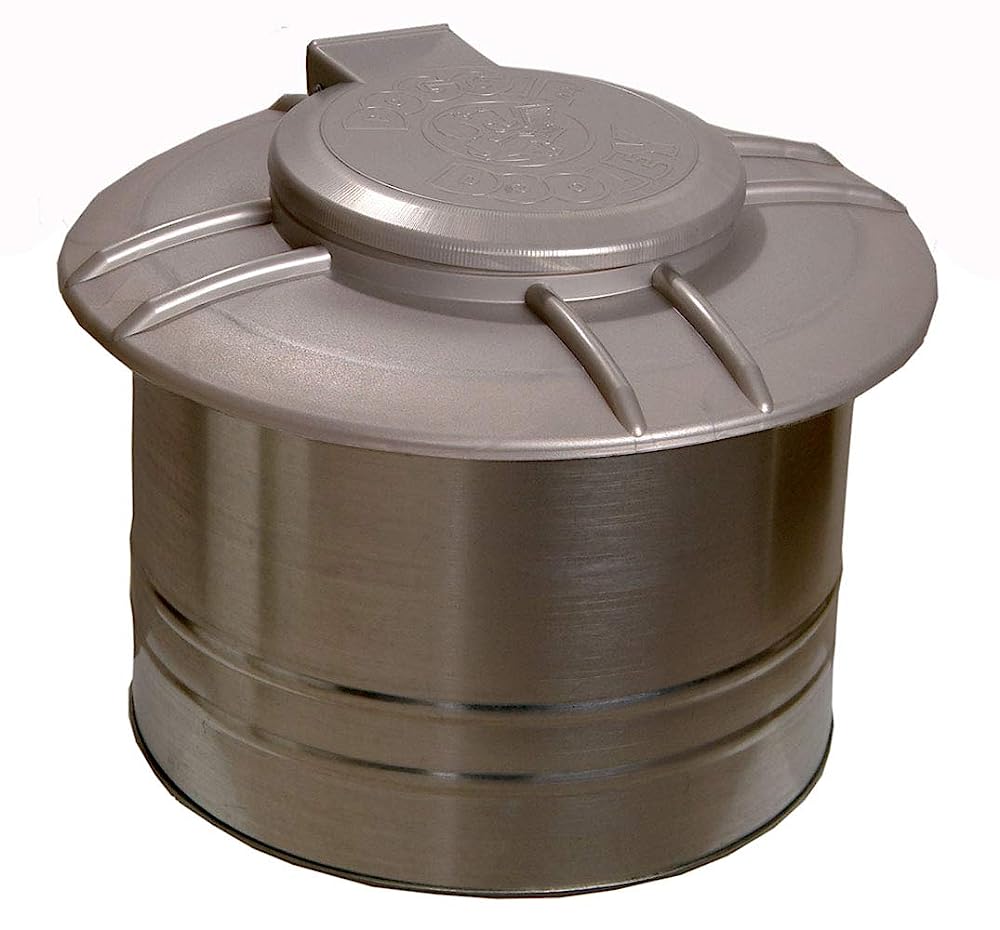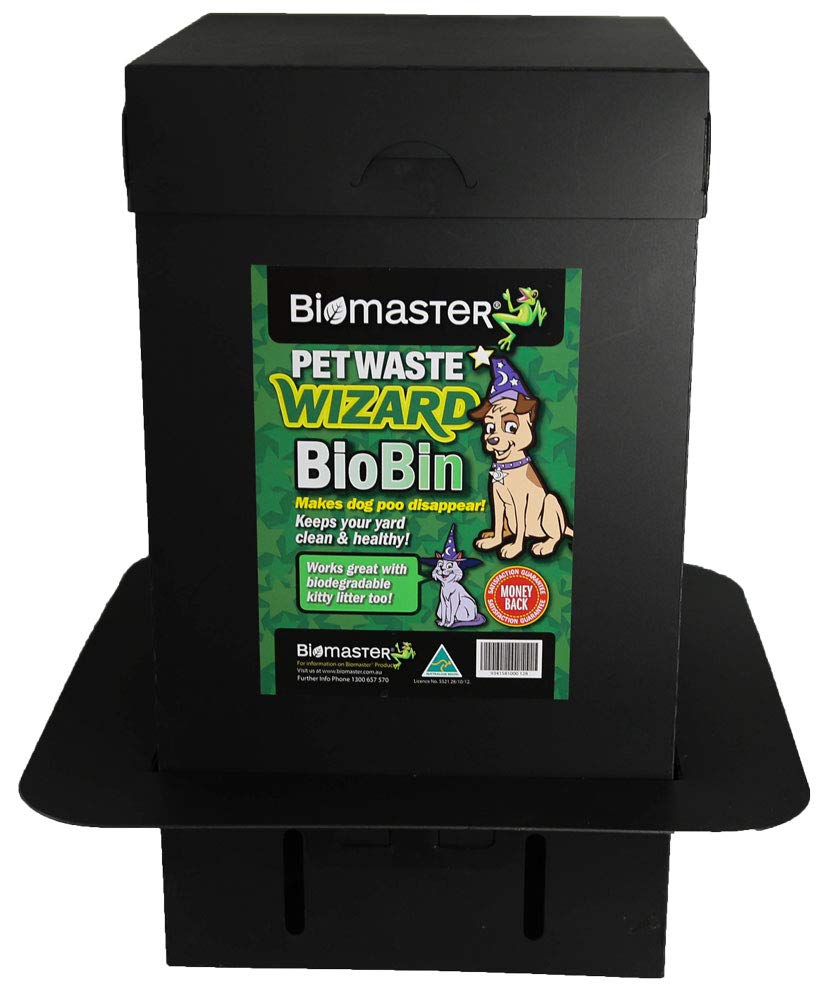iHeartDogs is reader supported. Some of the links below may be paid affiliate links, where we receive a small commission on a product at no additional cost to you.
Managing pet waste is a perennial challenge for dog owners. While many opt for the convenience of plastic bags and trash cans, an increasingly popular, eco-friendly option is the use of in-ground dog poop composters. These units allow you to dispose of your dog’s waste right in your backyard, reducing landfill waste and even enriching your soil. This article will guide you through the best in-ground dog poop composters, providing an efficient and green solution to a somewhat messy problem.
#1 – Doggie Dooley “The Original In-Ground Dog Waste Disposal System, Black with Green Lid (3800X)
The Doggie Dooley “The Original In-Ground Dog Waste Disposal System” is a pet waste disposal system that is designed to be installed into the ground. It is environmentally safe and can accommodate the waste of 2 large dogs or 4 small dogs. The system works similarly to a miniature outhouse and includes a plastic tank, extension panels, and a foot-operated lid opener. It is made in the USA and comes with a starter pack of digester.

#2 – Doggie Dooley 3535 35th-Anniversary Leach-Bed-Style Pet-Waste Disposal System Large
The Doggie Dooley 35th-Anniversary Leach-Bed-Style Pet-Waste Disposal System is an environmentally safe way to dispose of pet waste in the ground. It is designed for one large dog or two small dogs and operates similar to a home septic system. The system is made of durable plastic and features a foot-operated lid opener. It also includes a 6-month supply of Digester, although the duration of the supply depends on usage. The product measures 14 by 14 by 10 inches.

#3 – Doggie Dooley 3000 Septic-Tank-Style Pet-Waste Disposal System
The Doggie Dooley 3000 is an in-ground pet waste disposal system that is designed to be environmentally safe. It is suitable for households with 2 large dogs or 4 small dogs and operates similarly to a miniature septic tank. The system features a galvanized steel tank, a foot-operated lid opener, and is proudly made in the USA. It also comes with a digester and measures 13-3/4 by 13-3/4 by 15 inches.

#4 – Pet Waste Wizard BioBin Pet Waste Disposal Unit, Waste Digester (100% Recycled Material, 10” Width x 18” Height)
The Pet Waste Wizard BioBin Pet Waste Disposal Unit is a waste digester that efficiently breaks down pet waste, reducing odor and promoting a healthier environment. It is made from 100% recycled material and is easy to use, with bonus digester sachets included. Installing the unit is hassle-free, eliminating the need for deep holes. Additionally, the waste digester transforms pet waste into fertilizer and attracts worms to your garden, all while using a 100% carbon-neutral certified production process.

How Does an In-Ground Dog Poop Composter or Disposal System Work?
An in-ground dog poop composter or disposal system works essentially like a miniature septic tank, leveraging natural processes to decompose waste. Here is a basic outline of how it works:
- Placement: First, the composter is dug into the ground in a suitable location, often away from edible plants and water sources. It should also be in a place where the soil drains well.
- Adding Waste: After each pet waste collection, you deposit the dog poop directly into the composter.
- Adding Enzymes and Water: You’ll then add a special enzyme or bacteria mixture (usually supplied by the manufacturer and/or can be purchased separately) and water. These enzymes and bacteria help break down the waste and accelerate the composting process. They’re safe, natural, and non-toxic.
- Decomposition Process: The waste, water, and enzyme mixture will start to break down in the composter. This decomposition process transforms the dog poop into a nutrient-rich liquid that safely seeps into the surrounding soil.
- Maintenance: Regular addition of water and enzymes, as well as occasional stirring or agitating, will ensure the composter continues to work effectively.
Remember that dog waste compost should not be used on edible plants due to the risk of transmitting parasites and diseases. However, it can provide valuable nutrients to trees, shrubs, and flowers.
Frequently Asked Questions About In-Ground Dog Poop Composters
- What is an in-ground dog poop composter? An in-ground dog poop composter is a device that allows you to dispose of your dog’s waste in an environmentally friendly way right in your backyard. It works like a miniature septic system, decomposing the waste into a nutrient-rich liquid that safely seeps into the surrounding soil.
- Is it safe to use an in-ground dog poop composter? Yes, it is safe to use an in-ground dog poop composter as long as it is installed and maintained properly. The waste should be kept away from water sources and edible plants due to potential contamination. Always follow the manufacturer’s instructions for installation and use.
- Can all dog poop be composted? Most dog poop can be composted. However, if your dog has been dewormed recently or is on any medication, consult with your vet first. Some medications can affect the composting process or result in compost that’s unsafe for certain uses.
- How often do I need to add the enzymes? The frequency of adding enzymes varies depending on the size of your dog and the specific composter’s instructions. However, typically, enzymes are added with each new batch of waste or once a week. Always follow the manufacturer’s guidelines.
- Can I use the compost from the composter in my vegetable garden? No, compost from dog waste should not be used on vegetable gardens or any other edible plants. This is due to the risk of transmitting parasites and diseases. It can, however, be used around ornamental plants and trees.
- How long does it take for the waste to decompose? The decomposition time can vary depending on factors such as the outside temperature, the size of your dog, and how often it uses the bathroom. Generally, decomposition occurs over a few weeks.
- What do I do if the composter starts to smell? If maintained properly, an in-ground composter should not produce a strong odor. However, if you notice an unpleasant smell, it might be due to overfilling or insufficient enzymes. Try adding more enzymes, stirring the mixture, and/or adding less waste.
- Does the composter work in winter? Cold temperatures can slow down the composting process significantly. If you live in a region with cold winters, you might need to consider alternative solutions for those months, such as indoor composting or traditional disposal methods.
- Can I move the composter once it’s installed? It’s generally best to choose a suitable location from the start, as moving the composter can be a messy task. If you absolutely need to move it, you should empty and clean it first.
- Do I need to clean the composter? Regular maintenance, like adding enzymes and stirring the mixture, usually keeps the composter clean. However, if you notice issues like persistent odors or reduced effectiveness, a thorough cleaning might be necessary. Be sure to wear protective gear and follow the manufacturer’s cleaning instructions.
Conclusion: Best In-Ground Dog Poop Composters
Choosing the best in-ground dog poop composter is a step towards a more sustainable lifestyle. By composting your pet’s waste, you not only contribute to the reduction of the landfill but also create an enriching supplement for your non-edible plants. While the best choice depends on your specific circumstances and preferences, it’s important to remember that any composter should be managed correctly to ensure safety and efficacy. Through the knowledge gained in this article, we hope you are better equipped to make an informed decision and contribute positively to our environment, one scoop at a time.

 Toledo, United States.
Toledo, United States.
